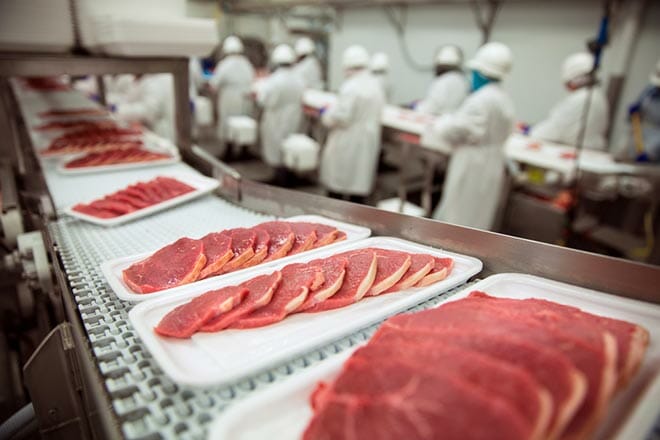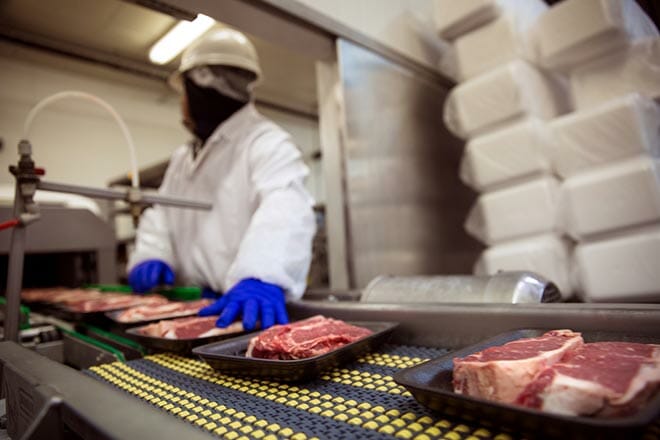The Centers for Disease Control and Prevention estimates that 48 million Americans experience a food borne illness every year. Of these victims, 128,000 end up in the hospital and 3,000 die.
Statistics tell only part of the story, of course. Cross contamination examples include pathogens—such as Listeria and Salmonella, and allergens, such as peanuts—getting into food during production, processing, distribution or preparation.
But food processing floors seems to take the brunt of the blame. Food handlers and processors must be especially concerned with preventing cross-contamination—the passing of pathogens or allergens from contaminated to uncontaminated food. Safety is critical, not only for health but also for processors’ bottom line.

Cross-Contamination Prevention: A Six-Point Plan
So how does cross contamination occur? Well, it’s actually very difficult to properly pinpoint the source of cross-contamination. Instead of focusing on attacking the source, shifting attention to eliminate the source through prevention is often key to creating a successful food safety plan. While this approach specifically addresses Listeria, it seems to suggest a much broader application.
Here are the major steps in creating a preventive “equation”:
- Keep raw and ready-to-eat (RTE) foods separate
- Always follow Good Manufacturing Practices (GMP)
- Focus on floors
- Pay attention to how equipment and facilities are designed
- Establish informed sanitation procedures and controls
- Monitor the processing environment
Separate RTE and raw. Pathogens can travel easily through the air, on skin and clothing and by other means. Creating a clean area means separating the area physically, controlling traffic, establishing decontamination stations and perhaps even setting up a separate HVAC system.
Stick with GMPs. Good Manufacturing Practices are long-standing principles that best help prevent the formation of points where cross-contamination can occur. They cover both production matters, including color-coding equipment for different hygiene levels, and personnel practices, such as washing hands and wearing hairnets.
Look to the floor. Wet floors are the most conducive to pathogen growth, but even dry floors can be a source of cross-contamination. Floors must not only be cleaned thoroughly and often; they also need to be maintained to avoid the formation of “niches,” such as cracks, where pathogens can hide from cleaners and multiply.
Check your current equipment. Over time, your processing equipment may need to be replaced. The key is detecting any flaws and taking action to correct them. A piece of equipment might have a “niche” that bacteria find welcoming. Cleaning techniques have to take this issue into account. Replacing your equipment with new, crevice free, 3A sanitary strainers is one simple, cost effective way to improve your processes and prevent cross contamination of food.
Set up smart and inclusive sanitation procedures and controls. Not all food processing plants are alike when it comes to consumer safety. Procedures and controls have to fit each different plant, taking into consideration all aspects of processing. Done correctly, establishing procedures and controls will increase efficiency, lower costs and, most important, protect consumers.
Monitor everything. Monitoring a sanitation program helps food processors learn from history. When adverse events, such as a roof leak or a pathogen outbreak, occur, response will be faster and more effective.

How to fight an invisible foe
Preventing cross-contamination in food processing is a formidable challenge. Food processors face an enemy they can’t see and one that can cause big problems. To stay ahead in the battle and have the right sanitary formula, they have to:
- Take a holistic approach that considers the entire facility and how one part of the facility interacts with all the others
- Pay attention to important “niches” in the structure, infrastructure and equipment the plant uses. If any damage is noticed, replace your current equipment with 3A sanitary strainers.
- Think like a pathogen. Where can it hide? How can it move from place to place? What makes the environment hostile to bacteria, viruses and allergens?
For more than 105 years, the experts at Newark Wire Cloth Company have specialized in fabricating standard and custom wire mesh products, including SaniClean Strainers. Contact the company for more information on the best cross-contamination prevention tips and about wire mesh and its applications in the food and beverage industry.
